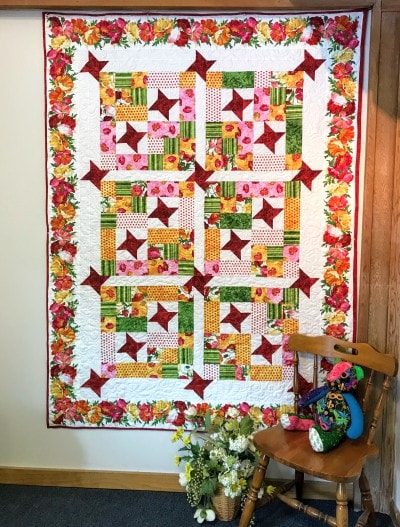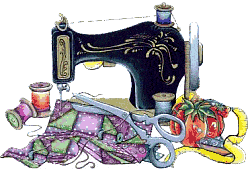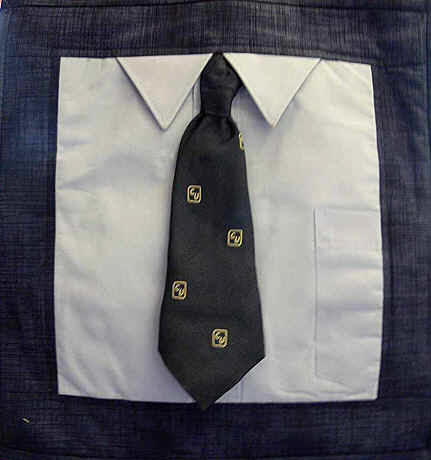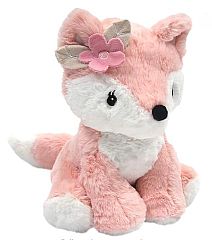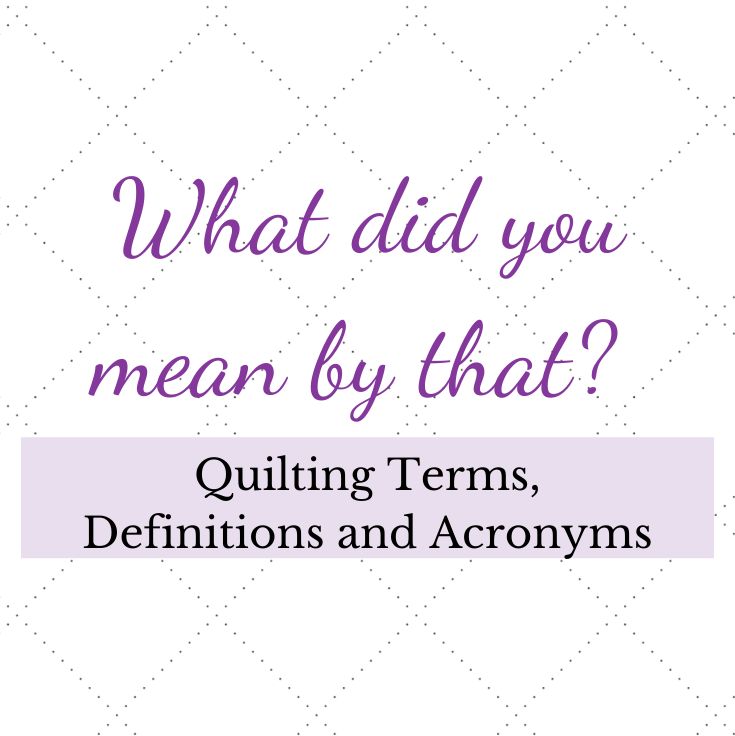*This post MAY contain affiliate links. That means that if you make a purchase after clicking on a link I may earn a small commission at no extra cost to you. I don’t ever recommend something that I don’t use myself. Not all links are affiliate links. For more information, see our Privacy Policy.
Definition of Quilting Terms and Acronyms
Quilters use a secret language all their own! Here are some definitions to help you translate quilting language.
Page One: Terms A – C
Page Two: Terms D – P
Page Three: Terms Q – Z
Acronyms used by quilters
- BDNQ = Bad Day, Not Quilting
- BOM = Block of the Month
- BSK = Basic Sewing Kit
- DQ = Dragon Quilt (A quilted that is dragged many places to be finished)
- DSM = Domestic Sewing Machine
- FART = Fabric Acquisition Road Trip
- FMQ = Free Motion Quilting
- FOB = Fear of Binding (thanks, KayEllen!)
- FPP = Foundation Paper Piecing
- FQ = Fat Quarter
- FW = Featherweight
- HIPS = Hundreds of Ideas Piling Skyward (thanks, Mavis!)
- HST = Half-Square Triangle
- HSY = Haven’t Started Yet
- LAQ= Long Arm Quilter
- LQS = Local Quilt Shop
- MAQ = Mid-Arm Quilter
- NESTY = Not Even Started Yet
- OBW = One Block Wonder
- PFC = Professional Fabric Collector
- PhD = Projects half Done
- PIGS = Projects in Grocery Sacks
- PIPS = Projects in Pizza Boxes
- PP = Paper Piecing
- QAL = Quilt Along
- QAYG = Quilt as You Go
- QST = Quarter Square Triangle
- RR = Round Robin
- SA = Seam Allowance
- SABLE = Stash Accumulation Beyond Life Expectancy
- SEX = Stash Enhancing eXperience (or eXcursion)
- SID = Stitch in the Ditch
- SnW = Stack n Whack
- SOG = Straight of Grain
- SQUID = Sewing a quilt until I die AKA Dragon Quilt
- Squishy = envelopes full of fabric sent by mail
- STASH = Special Treasures All Secretly Hidden
- TGIF = Thank God It’s Finished!
- TOT = Tone-on-Tone
- TUS = The Usual Supects – items to bring to class
- UFO = UnFinshed Object
- WHIMM = Works Hidden In My Mind
- WIP = Work In Progress
- WISP = Work In Slow Progress
- WIWMI = Wish it would make itself
- WOF = Width of Fabric
- WOMBAT = Waste of Money, Batting, and Time
- WOW = White On White
- WWIT = What was I thinking?
Quilting Terms A – C
Album Quilt A quilt made of many different blocks, often with symbolic designs appliquéd or stamped on each block. If each block is signed it would be an Autograph or Signature Quilt.
Amish: The Amish people are a religious culture. Their antique quilts tend to use rich jewel-toned solid fabrics with black as a background, often in striking geometric patterns, and wide, plain borders. Central medallion square-in-a-square with wide borders is a popular design.
Modern Amish quilts made for resale can use any fabric in any design but retain the excellent quilting. Although there are Amish people in all 50 states and several Canadian provinces, the Amish quilt resale trade is generally found in Pennsylvania, Ohio, or Indiana. By the way, it’s a myth that the Amish deliberately put a mistake in their quilts because only God can make something perfect.
Appliqué: a piecing process using small amounts of fabric which are then sewn onto a background fabric in a decorative design such as curved floral or animal motifs. Appliqué can be done by hand, machine, or with fusible web. and is often combined with pieced blocks or placed in the border to frame a pieced quilt. Appliqué is a great technique to cover stains, rips, or other problem areas. See our article on quilt applique.
Backing: the bottom or back layer of a quilt, usually a plain unadorned fabric that has been pieced to the width of the quilt. The backing is where you should put your label!
Baltimore Album Quilts: An elegant form of intricate appliqué that was very popular in mid 19th century in Baltimore, Maryland.
Bare Feet: a device for finding pins in a carpet.
Basting: Long stitches used to hold the top, batting, and backing of a quilt together while the quilting is being done and removed when the quilt is completed. A quilt can also be basted with curved safety pins, a tacking gun, or a spray adhesive. Fusible batting is also available.
Batik: Batik fabrics are made by covering a design area with wax or other substance to prevent dye from penetrating into that area. Indonesia is famous for its batiks. They are usually high-thread-count fabrics. Use a #12 Microtex needle with this fabric.
Batting: Sometimes called wadding or stuffing, this is the layer in the center of the quilt sandwich, giving it warmth and thickness. Batting can be cotton, polyester, blends, silk, or wool.
Bearding: The migration of fibers from the batting passing through the quilt top and forming a fuzz on the surface of the quilt, thought to be caused by static electricity. Most often associated with cheap polyester battings, bearding can also happen with unbonded cotton. Some synthetics, wool, and silk batting are also prone to this problem.
To help prevent this, prewash fabrics using a quality fabric softener and a dryer sheet. Quilt using a mercerized or coated thread. Apply beeswax or spray your thread and/or quilt layers with a fabric silicon spray. This will also help prevent thread breakage. Never store your quilt in plastic. A humidifier in your workroom is beneficial to both the quilt and quilter!
Betweens: small, thin needles used for finish quilting. Sizes range from 8-12, the smaller number being a longer-length needle.
Bias: The diagonal direction across the surface of a woven fabric at a 45º angle to the line of the warp and weft. Fabric cut on the bias stretches easily and must be handled with care. A 45º angle is called a true bias – fabric cut at a 30º or 60º angle can also be considered a bias cut. Bias binding allows binding to be turned and angled without pleating.
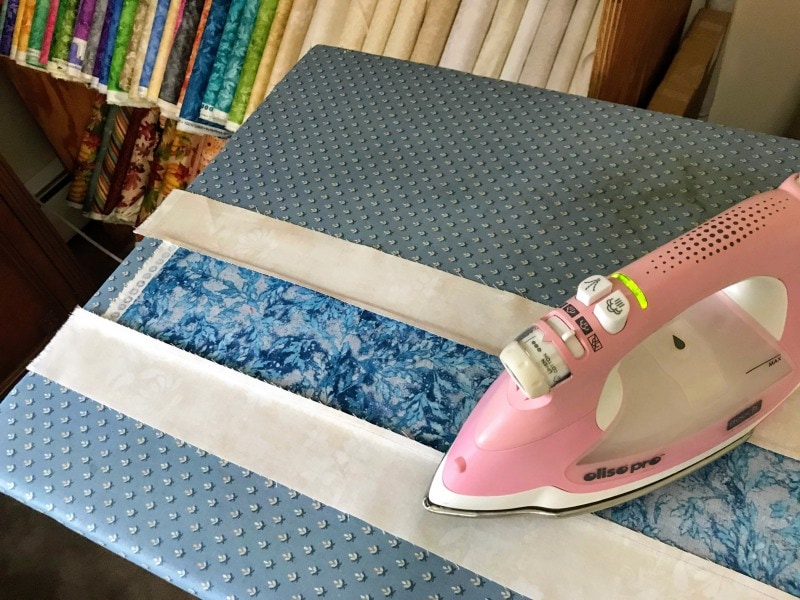
Big Board: A very large ironing board, usually 24″ x 60″, which is placed over your existing ironing board to give you a larger surface to press your fabrics. It can be purchased commercially for $99 – $130, or you can make one at home. Use 1/4″ plywood with 1″ x 1″ strips on the underside to keep the ironing board in place. Use batting or mattress pads for the padding and muslin or ironing board material for the cover.
Big stitch: a type of quilting in which embroidery or crewel thread is used in large stitches for a decorative effect.
Binding: A strip of fabric sewn over the edges of the quilt layers to finish the raw edges, add strength, and/or decorate the edge. Normally a binding is sewn on one side, then brought over the edge to the other side where it is secured, but binding can also be a part of the backing wrapped over to the front. Binding can be straight or cut on the bias. How much fabric will you need? Click here for a chart. See our article on choosing your binding.
Birthing a quilt: The method of sewing the quilt batting and backing to the outside edges of the quilt (right sides together), then turning the whole thing inside out as if it were a pillowcase. If you have laid out the layers correctly, the batting will be in the middle, and you can slip stitch the quilt pillow closed. This can also be called a knife-edge finish.
Blindstitch: A type of invisible stitching often used for appliqué
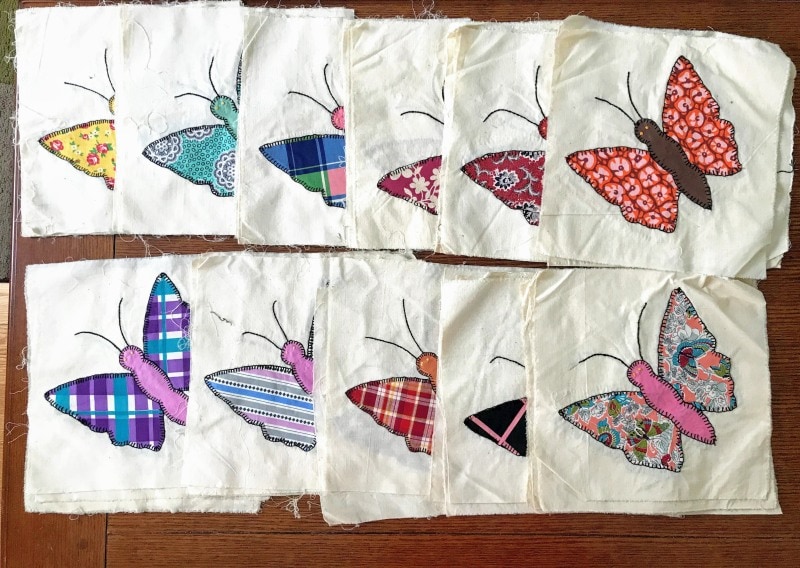
Blocks: Most quilt tops are constructed by sewing together smaller units called blocks in a certain layout.
Border: a strip of fabric sewn to the outside of a quilt top to serve as a frame for the interior or to enhance the design. Click here for help on measuring a quilt border. See our article on choosing a border for your quilt.
Broderie Perse: The French word for “Persian Embroidery”. First made popular in the early 1800s when cotton was extremely expensive, the technique is a type of appliqué where larger images such as an animal or a flower are cut from a piece of printed fabric and appliquéd to a background fabric.
Bubble Jet Set: (BJS) is a liquid product that makes ink colorfast on fabric. Plain fabric is soaked in BJS and hung to dry. The dry fabric is then ironed to a piece of freezer paper and used in an inkjet or bubble jet printer to print pictures or text.
The Burn Test: for Identifying Textile Fibers. See Determining Fabric Type.
Calico: In the 19th century, calico referred to any type of cotton fabric. It is still used in that sense in England and Australia. In the US, it is often used to refer to fabric with a small repeated design, usually florals or leaves.
Cats: purring device designed to add enjoyment and hair to your latest quilt.
Chain sewing: To chain sew is to feed block pieces into the sewing machine one right after the other, without snipping threads in between each seam. This allows you to sew many pieces without stopping after each one, saving both time and thread.
Challenge: a competition to create a block or quilt using specified fabrics or patterns.
Charm Quilt: A quilt made of many small pieces of fabric where each piece is a different fabric. The idea is to have a scrap-pieced top with no two pieces alike. The pattern is usually a one-patch design. Charms are often exchanged and traded by quilters.
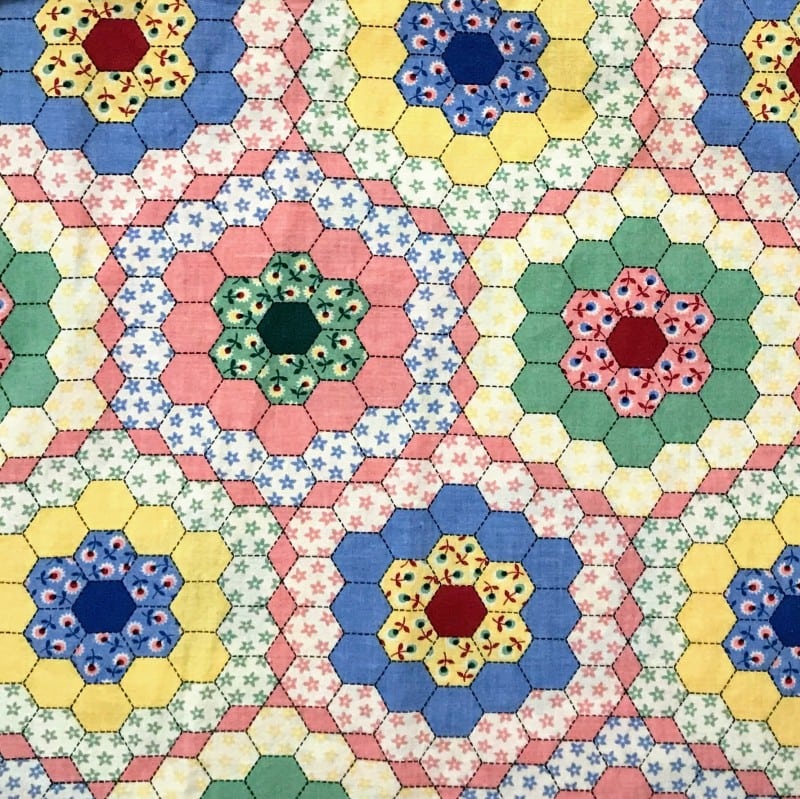
Cheater cloth: fabric printed with an all-over quilt block design, made to look like a pieced or appliquéd quilt top.
Chemotherapy Caps: These are wraps or turbans worn by people who need to cover their heads to conceal hair loss. These should be 100% cotton.

Chenille: Chenille is a type of fabric that consists of many layers, sewn, stitched, and fluffed to make it bloom. Here is an article on how to make chenille fabric.
Color Wheel: click here for a helpful article.
Corner Setting Triangles: If you would like to set your block on point and add half-square triangles to the four corners to make it square again, how do you figure out the size of the square to cut in half? Click here for an illustrated article with charts on side setting triangles, corner setting triangles, and setting a block on point.
Crazy Quilt: a block assembled from irregular and often scrap pieces, with no set pattern or design overall. Can be made as small blocks and assembled into a larger piece, or sewn as one complete quilt top. A popular pattern during the Victorian period, it was made with silks and velvets and embellished with much embroidery.
Curved Piecing: used in Drunkards Path and other blocks.
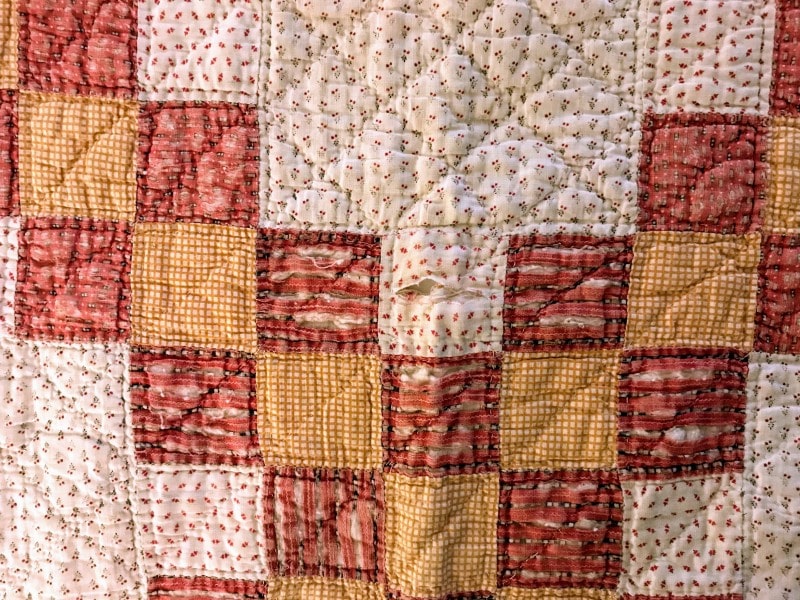
Cutter Quilt: a quilt that is so badly worn or damaged in some areas as to be sold for the purpose of cutting it up into pillows, dolls, or other craft items.
